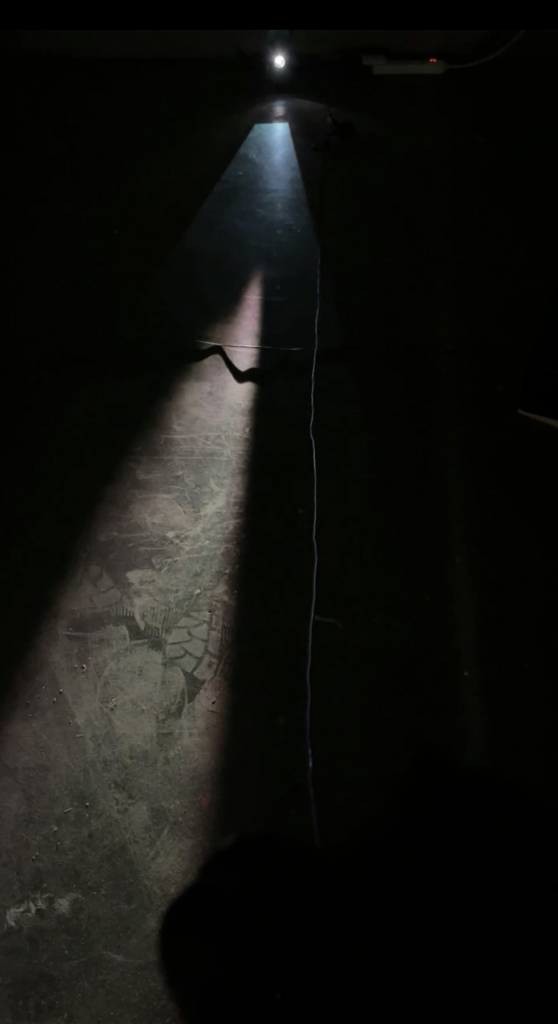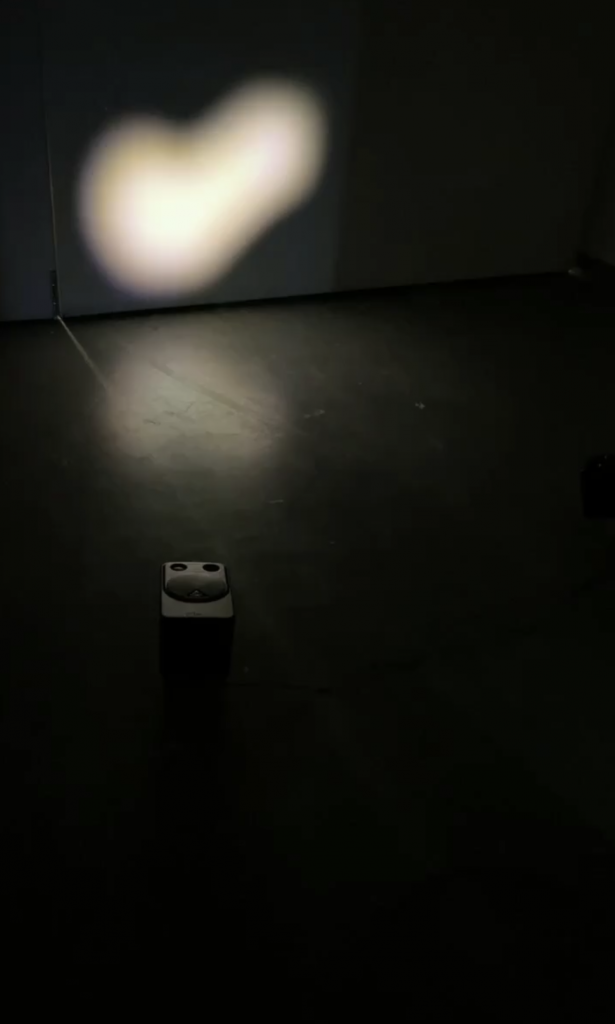Project Motion-Motion: reuniting sound and visual
The piece is enclosed in a small, white-walled room, about fifteen by twenty feet, with one closed door and no windows. The audience enters a dark room with a sliver of light which splits the darkness at the centre of the room. Standing at the edge of the room you can see the light gently drift up and down the wall and back and forth across the floor. Emanating from the base of the wall, where it meets the floor on one side of the room, the source of the beam of light emits a modest mechanical whirring. There is just enough light to beckon, and as the audience enters, they are met with a consistent and distinct, but indistinguishable sound. A cord is illuminated, skimming the floor, crossing the beam of light where a pair of headphones lie casting a long shadow. Blinking into the darkness the audience might be straining to feel into the senses to try to map the new environment. The sound, now recognized as intentional, also comes from the floor. With this understanding comes a keen awareness of the body in this space, and a sense of vulnerability to obstructions at ground level necessitates a careful maneuvering through the room. The soundtrack, which at this point resembles static, is subtle and familiar as it comes and goes. By moving further into the space and putting on the headphones, the listener is positioned within the beam of light, which now draws up the body and back down to retreat across the room. With the headphones on, it’s as if the sound seeps into the ears of the listener for a brief moment and then draws back again as it fades out of the headphone track and grows louder in the speakers. It’s the timing of these two separate tracks that is intended to create the illusion of sound travelling. The headphones act as a barrier which the sound passes through to create an intimate, internalized performance of the sound. At this point the audience might be tracking the light while trying to confirm the location of the sound. They might be sensing the immaterial motion in the space. As they attune to the environment, the audience may begin to feel involved, implicated. They might even recognize the triangulation that their body completes in space between the light and the floor, the speakers and headphones.
This project was inspired by Tim Ingold’s lecture Noise Sound Silence, in which he brings attention to the senses and stimulus, positing their independent generation. Proposing that the receipt of light and sound might actually be generated in our heads, Ingold grounds his theory in the case of individuals experiencing sound and light in the absence of such stimulus.
As mentioned, the sound present in Motion-Motion is elusive. It is akin to the drone of a fan, heavy rain, or water running through pipes. I have employed white noise in order to work with sound as material, tempering the space. Created from an equal measure of all perceptible frequencies, white noise pads the environment of the listener from veritable sonic events and punctuating sounds. I use volume as a marker for distance. Unlike the ability to shut our eyes, we cannot control the intake of sound, so we use proximity, making sound a determiner of space. By this very method, I am offering layers to the auditory space in hopes that the audience may start to make a distinction between their own body (internal state) and their surroundings. It is my intention that, enveloped in a solitary experience of sound while wearing the headphones, sharing the experience of sound in close proximity with others helps to define, with sound, the degrees of separation between the mind, as an internal thought process, and the shared environment.
There’s a certain firmness to the space that houses this work. Clean and empty, it’s a multi-use space with a slight sterile air of exhibition. I find the function of the white cube gallery space is often to create a sense of removal, so that art can seem suspended, without unintended references. In this case, it functions as a challenge to the boundaries of space, highlighting the containment that enables its reception.
In the development of the sound track for Motion-Motion I recorded my own extended exhale with a contact mic, then looped it in its most steady moment, for seven minutes of sustained sound. This mediation of my breath resembles waves crashing, and I am emulating the recycling of this consistent sound. Along with white noise, there is also “pink noise”, “brown noise” and “blue noise”–mimicking, with frequency, the levels of the color spectrum. Given the sonic environment, I found the slightly higher frequency of my exhale to nestle-in nicely with the other sounds present in the installation–the whirring of the projector, the rumble of trucks passing on Great Northern Way, and the buzz of a campus full of fluorescent lights. This audibly blue-noise soundscape serves to gently lift the focus from the incidental noise floor to an intentional composition.
Ingold notes of the experience of light and sound, that
an impervious boundary separates mind and world and mediates our exchanges between them and that boundary is the body, including its sensory organs, and the touch sensitive envelope of the skin. […] Light and sound are neither in here or out there… the very experience of light or of sound is one in which the boundary is dissolved.
In considering this boundary, I intend the light and sound in Motion-Motion to permeate the borders of the body in a way that the audience might take note of.
The blue-noise soundtrack in Motion-Motion was animated by an embodied technique that I have developed, that spatializes sound using the movement of my body. The looped blue-noise was played back through a speaker acting as a single source of sound. I then recorded this single point of sound in space using in-ear binaural microphones. While wearing the microphones I moved my body in space, actively recording the blue-noise track in different positions around my moving body. I moved towards and away from the speakers paying attention to how my weight swayed. I moved through circles, spirals and figure-eights created by my body. The result is a binaural audio track which features the blue-noise moving autonomously in space, reanimating the sound around the body of the listener. The sound moving this way is a gesture, traced by the movement I carefully perform. I believe that the listeners can sense the performance of authentic movement, this it is not digitally rendered, but perhaps only subconsciously.
The development of the moving, projected light echoes the embodied process which spatialized the sound in Motion-Motion. I recorded this same movement standing between a source of light and the camera, inverting the colors and increasing the contrast. The result is a shadow made of light swaying and swooping across the screen. When the video is projected, it creates light which also moves throughout the room as if it had a physical form.
What Motion-Motion presents to the audience is the final product of these two embodied processes, producing a duet of moving light and sound. The binaural recording of the blue-noise is played in-tandem with the moving light projection in the installation. Fulfilling seven minutes of a fluctuating ebb and flow throughout the space, light and sound are exchanged between the body of the listener, the projector, and speakers.
The sense of boundaries permeated is produced through the use of two separate tracks playing the same binaural blue-noise. One plays through the headphones and one plays through the speakers. The headphones and speakers take turns transmitting the blue-noise fading in and out at a rate similar to a cycle of breath or waves breaking and withdrawing. The effect is an auditory illusion of the blue-noise track moving back and forth between the speakers and the headphones. Entering the room, the listener might hear the sound coming through the speakers, or they may encounter the effect of the light first and find the headphones placed at the intersection of the action. While there is still a presence beyond the walls of the exhibition space it feels somehow sealed off from the current experience. Putting on the headphones and finding the sound here, just as it disappears, results in much of the volume from the speakers being blocked by the headphones. The headphones create the final level of impasse.
Motion-Motion works with the immaterial, activated by darkness. The provisional nature of the setup–speakers, headphones, and a projector on the floor, laid bare–are overlooked in the dark. Distraction from the technical setup is meant to direct attention inwards, to feel the body and sense within the space and is not meant to deceive the audience. While the light is an invitation to participate and situate within the installation, it also illuminates the sources of sound, depicting the gear as-is, functioning as a point of departure. I strive to soften the presence of technology while sensitizing the body, so that light and sound become perceptual material. The tech laying on the floor is reduced to a tool as I attempt to strip it of its typical role in enchanting an audience, while gate-keeping its production.
Proprioception negotiates the boundary of the body as it encounters the surrounding space. By bringing attention to the bodily boundary, what is ours and what is other is temporarily bridged and, perhaps for a moment, we can leave our immediate bodily circumstance.
The entire installation is a culmination of several layers of development, actions that may not be recognized but surely play a part in creating a more specific uptake of the work. Motion-Motion, and everything it encompasses, runs on a synchronized loop. The effect is the opposite of a performance, where the events transpiring in the space are independent of any audience. This places the choice to enter, to stay and to exit on the audience. A natural hesitancy in darkness and an unwillingness to spend time are inherent conditions of the installation. This room, sequestered from the rest of the activity in the building, is also a bid for an intimate and grounding moment. The speakers and the projector placed on the floor means that, relative to the high ceilings, the work is happening low to the ground. As the light from the projector grazes the slickness of the floor it reflects and disperses some of the light upward, creating a more three-dimensional sense of the moving form of light. I have a particular affection for the floor and find that when called to acknowledge the foundation beneath my feet I become more aware of my body and of the conditions around my being here and something settles a little. The experience is relatively ambiguous and the invitation isn’t entirely prescriptive. With this I hope to create a space where the audience engages with the work through self-reflection and sensation and takes the chance to be with themselves and embody the perceptible motion.

